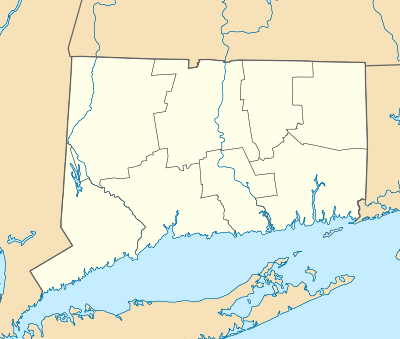Clinton Village Historic District (Clinton, Connecticut)
The Clinton Village Historic District encompasses the historic portion of the town center of Clinton, Connecticut. It is roughly linear and extends along East Main Street (United States Route 1) from the Indian River in the west to Old Post Road (Connecticut Route 145) in the east. The area represents a well-preserved mid-19th century town center, with architecture dating from the late 17th to mid-20th centuries. The district was listed on the National Register of Historic Places in 1994.[1]
Clinton Village Historic District | |
 | |
  | |
| Location | Along Cemetery Rd., Church, E. Main and Liberty Sts., Old Post Rd. and Waterside Ln., Clinton, Connecticut |
|---|---|
| Coordinates | 41°16′36″N 72°31′7″W |
| Area | 120 acres (49 ha) |
| Architectural style | Colonial, Federal, Greek Revival |
| NRHP reference No. | 94000788[1] |
| Added to NRHP | July 29, 1994 |
Description and history
The area that is now Clinton was settled in 1663, and was incorporated in 1838, separating from Killingworth. Liberty Green, a small triangular park at the junction of East Main and Liberty Streets, is a surviving remnant of the community's town common and militia training ground. Land for a meeting house and cemetery were also laid out at an early date, now located on Church Street at the western end of the district. This area would serve as the town center of Killingworth (incorporated 1667) until the two towns separated. The town grew as a modest coastal community, serving local farmers and passing travelers on the Boston Post Road (now US 1), then the major road through the region. In the 1840s, Liberty Green was transformed into a park. Economic development of the town center shifted westward across the Indian River in the late 19th century, because the railroad station was located there, leaving the eastern portion of the town with a more distinctively mid-19th century character.[2]
The district comprises 154 buildings, objects, sites, and structures that contribute to the historical and architectural significance of the area. Most of these are arrayed along East Main Street, with major spurs along Liberty Street to the north and Waterside Lane to the south. The oldest house, known as The Arsenal, stands on Waterside Lane and is believed to date to 1675. The most common architectural style in the village's many houses is the Greek Revival, with features such as corner pilasters and entablatures sometimes applied to older buildings, as well as being found on period buildings of the 1830s and 1840s.[2]
Historic buildings
Some of the historic buildings and structures located in the district are:
- Clinton Volunteer Fire Department (1931)
- The Academy, now used by the Clinton Parks and Recreation Department (1801)
- Town Hall
- First Church of Christ (1837)
- Abraham Pierson Monument
References
- "National Register Information System". National Register of Historic Places. National Park Service. March 13, 2009.
- "NRHP nomination for Clinton Village Historic District". National Park Service. Retrieved 2018-04-27.